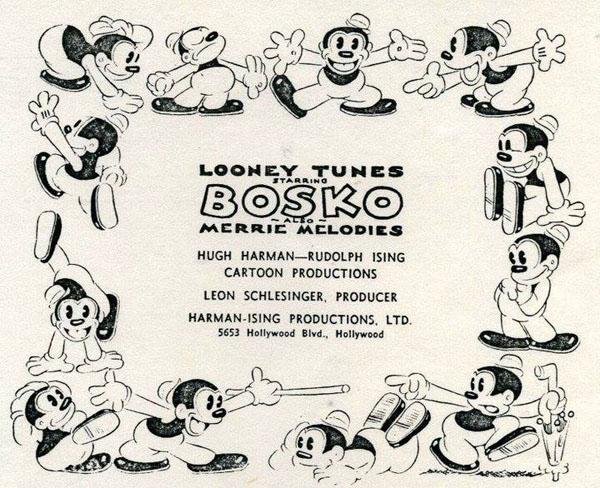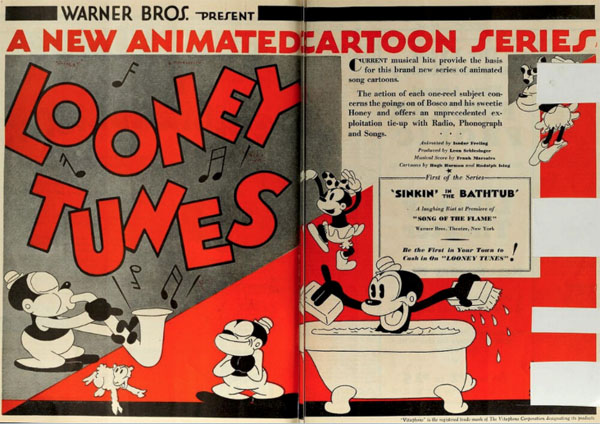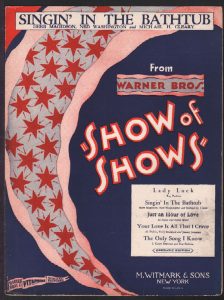
If you are like me, you grew up watching the Warner Bros. cartoons on television. Whether it was the Guild Films package of black-and-white “Looney Tunes” shorts, or A. A. P’s package of color “Merrie Melodies” cartoons, or the various network runs built around such characters as Bugs Bunny, Porky Pig, the Road Runner, or Daffy Duck–you couldn’t get away from Warner Bros. cartoons, even if you wanted to do so.
 Though music in the cartoons was variously credited to Frank Marsales, Bernard Brown, Norman Spencer, Carl Stalling or Milt Franklyn, the cartoons liberally used many Tin Pan Alley songs, as well as so many songs from Warner’s features and live-action shorts. And if your hobby is collecting records of the period, then two interests are conjoined.
Though music in the cartoons was variously credited to Frank Marsales, Bernard Brown, Norman Spencer, Carl Stalling or Milt Franklyn, the cartoons liberally used many Tin Pan Alley songs, as well as so many songs from Warner’s features and live-action shorts. And if your hobby is collecting records of the period, then two interests are conjoined.
By the summer of 1928, Warner Bros. Pictures, Inc. was flush with cash, and willing to spend freely. The firm bought three music-publishing houses– Chicago-based Miller Music, and two that were headquartered in Tin Pan Alley; Robbins Music; and Leo Feist, Inc. The three publishing houses were wadded up all together, and were christened “the Big Three”.
Warner’s officials were very eager to push songs that would become part of the Great American Songbook–and which originated in Warner’s feature films, which by the 50’s were coming to television at the time that the cartoons were getting shown as kiddie-show fodder.
 Indeed, there was a clause in the contract between Warner Bros. and Leon Schlesinger (former head of Pacific Art and Title, who probably realized that his former business was going to fall on hard times, now that pictures could talk–there was almost no need for intertitles anymore) that each cartoon had to have a full chorus of a Warner’s-published song. The cartoons proved good at promoting the songs. Indeed, some songs are more memorable from their appearance in animated form than in the movies in which they were first introduced.
Indeed, there was a clause in the contract between Warner Bros. and Leon Schlesinger (former head of Pacific Art and Title, who probably realized that his former business was going to fall on hard times, now that pictures could talk–there was almost no need for intertitles anymore) that each cartoon had to have a full chorus of a Warner’s-published song. The cartoons proved good at promoting the songs. Indeed, some songs are more memorable from their appearance in animated form than in the movies in which they were first introduced.
This new series of columns is devoted to songs that were used in Warner Bros. cartoons, who recorded them “live”, and who recorded some songs in the only form they would ever appear.
In the course of these columns, I will refer to some of the most popular–and commercially recorded – songs of the Twentieth Century.
Come with me, on this journey through musical history, in which I can lead, even with my gimpy eyesight.
You Gotta Start Somewhere

The ink was hardly dry on the contracts between Leon Schlesinger and Warner Bros. Pictures, inc. for a series of animated cartoon shorts which would bear the Warner’s shield and the Vitaphone pennant, when Schlesinger laid in a supply of black ink, pens and brushes, and all the supplies needed to make animated cartoons.
 A test film was made rather speedily, but Bosko, The Talk-Ink Kid did not have either a music score nor underscore. Instead, it had a plethora of dialogue, often delivered in flagrant dialect, with some decidedly cringe-worthy verbiage included.
A test film was made rather speedily, but Bosko, The Talk-Ink Kid did not have either a music score nor underscore. Instead, it had a plethora of dialogue, often delivered in flagrant dialect, with some decidedly cringe-worthy verbiage included.
The first short to be released to theaters, Sinkin’ in The Bathtub (1930), unlike its predecessor, had a full music score, credited to Frank Marsales, and a paucity of dialogue-much of which of was delivered in the then-accepted “Negro” style.
The film’s title was “inspired” by the “plug” tune from Show of Shows, one of those plotless revues that Hollywood studios kept churning out, during the course of which everyone they had under contract went before the camera to show that he, she, or it (they included Rin Tin Tin) could talk, sing and/or dance. “Singin’ In The Bathtub” was introduced by Winnnie Lightner, and delivered in a take-no-prisoners style derived from that of stage headliner Marion Harris.
 The rest of the cartoon featured a number of songs, some then-recently published by the 3 Warner’s’ publishing houses, after they had been used in an all-talking, all-singing, all-color extravaganza, Gold Diggers of Broadway (1929), as well as some “evergreens”. The latter include snatches of “Hearts and Flowers” (c. 1908), which was a standard in terms of its use to denote sadness or melancholy, and Daly’s famous “Chicken Reel” (c. 1910), a piece that connoted the barnyard, and anything associated with the rural, and “I’m Forever Blowing Bubbles” (1918).
The rest of the cartoon featured a number of songs, some then-recently published by the 3 Warner’s’ publishing houses, after they had been used in an all-talking, all-singing, all-color extravaganza, Gold Diggers of Broadway (1929), as well as some “evergreens”. The latter include snatches of “Hearts and Flowers” (c. 1908), which was a standard in terms of its use to denote sadness or melancholy, and Daly’s famous “Chicken Reel” (c. 1910), a piece that connoted the barnyard, and anything associated with the rural, and “I’m Forever Blowing Bubbles” (1918).
You can bet your bottom dollar that Carl Stalling remembered “Singin’ In The Bathtub” in later years. As late as 1952, he has Bugs Bunny singing a snatch of it in Forward March Hare, a service comedy starring a newly-drafted (or so he thinks) Bugs Bunny of El Slope-O, New Mexico.
 And Stalling remembered “I’m Forever Blowing Bubbles” in late years, as he would use it in Hollywood Steps Out (1940), as the accompaniment for the “bubble dance” of “Sally Strand”– a takeoff on Sally Rand, who was known for provocative dances that suggested she was (or maybe really was) au natural behind a giant-sized balloon, where she engaged in her terpsichore.
And Stalling remembered “I’m Forever Blowing Bubbles” in late years, as he would use it in Hollywood Steps Out (1940), as the accompaniment for the “bubble dance” of “Sally Strand”– a takeoff on Sally Rand, who was known for provocative dances that suggested she was (or maybe really was) au natural behind a giant-sized balloon, where she engaged in her terpsichore.
“Singin’ in The Bathtub” was widely covered by the record industry, large and small companies alike. Victor had a dance version by The High Hatters, a house orchestra directed by one Leonard Joy, with vocal refrain by Frank Luther (the future Children’s Record king), and a vocal record by Chick Endor, an entertainer/songwriter who had a reputation in the smarter nightclubs of New York and of London. Columbia asssigned the cantata to crooning Eddie Walters for a vocal version, while giving the dance version to new sensation Guy Lombardo and his Royal Canadians, now newly-installed in the Grill Room of the Roosevelt Hotel, New York–with easy access to Grand Central Station.
Brunswick had a vocal disc by busy Dick Robertson, a Canadian whose voice was regularly wrapped-around novelty songs, “city-billy” ditties, and regular pop songs.
Even in the smaller firms, the Bathtub ballad found a home. The so-called American Record Company gave it to one of the hottest acts in radio at the time, the vocal-and-crosstalk team of Billy Jones and Ernest Hare. And at Grey Gull – some of whose products sold for as little as one dime – one of radio’s first successful females had the song: Vaughn de Leath (under the pseudonym of “Glory Clarke”).
Over in England, “Singin’ In The Bathtub” was covered for “His Master’s Voice” (the label allied with our Victor records) by Britain’s most popular dance band, one Jack Hylton, and by a comedienne who was emerging as a major star on the radio, and eventually in other media as well. It was made available as sung in the broad Lancashire tones of Gracie Fields.


 James Parten has overcome a congenital visual disability to be acknowledged as an expert on the early history of recorded sound. He has a Broadcasting Certificate (Radio Option) from Los Angeles Valley College, class of 1999. He has also been a fan of animated cartoons since childhood.
James Parten has overcome a congenital visual disability to be acknowledged as an expert on the early history of recorded sound. He has a Broadcasting Certificate (Radio Option) from Los Angeles Valley College, class of 1999. He has also been a fan of animated cartoons since childhood.











































Hi,
I have been collecting records for over 60 years – growing up as a kid in the fifties and watching WB, Paramount,Buren etc/.cartoons on TV musically owe a great deal to them for opening up my eyes for early 1890 -1924 (pre ascap) songs. As I was grew up I was able in most cases found original records the Carl Staling and others used for background music and as a young person it helped to create a love for these early song and classical music.
Also one note that many of those (mostly) forgotten songs were used in background with at the time of the original releases add more jokes to the films. These are lost most of cartoon collectors -l luckily I am not one of those.
HS
I know I’m going to love this series. My mother used to sing along with the cartoons I watched when I was a little boy, so I became aware very early on how much the music contributed to the story and the humour.
I love it that WB’s “Singin’ in the Bathtub” takes a dig at MGM’s “Singin’ in the Rain” from the Hollywood Revue of 1929 — sung by none other than Cliff Edwards, by Jiminy!
I wonder how many other kids had the experience of stumbling upon one of the WB Busby Berkeley musicals when they first started showing up on TV and going, “Hey… wait a minute!” when somebody would break into “Shuffle Off to Buffalo” or “By a Waterfall,” or, or or…
Pretty sure the very first fragment of what I would come to recognize as music that I ever heard was the ascending pedal-steel glissando behind the WB shield, which zoomed up from out of nowhere.
I’ve not stopped paying attention since.
“By the summer of 1928, Warner Bros. Pictures, Inc. was flush with cash, and willing to spend freely. The firm bought three music-publishing houses– Chicago-based Miller Music, and two that were headquartered in Tin Pan Alley; Robbins Music; and Leo Feist, Inc. The three publishing houses were wadded up all together, and were christened “the Big Three”.”
I’m a little surprised that neither Harms, nor Witmark, nor Remick were mentioned here; all three were purchased by Warner Bros. in 1929. Furthermore, I was under the impression that Miller, Robbins and Feist were in MGM’s orbit, not WB’s.
Great beginning for a promising series. [Though I would agree with Eric; I think Miller, Robbins and Leo Feist were MGM-owned by the mid-’30s and were never Warner-controlled.]
“I’m Forever Blowing Bubbles” was heard in the background scores of numerous Warner and First National features; in the late ’60s, Georges Delerue arranged a lovely orchestral version of the song for the opening of Ken Russell’s WOMEN IN LOVE.
Just watched “Sinkin in the Bathtub” on Dailymotion, and wow! Pre Code! We see BosKo’s toilet! We see Toilet paper! We see Honey’s bra hanging on the line! Funny she has a bra when she appears to be topless, and Bosko not only has a toilet but an outhouse! Does that make it 1 1/2 baths?
I’m sure it is a surprise for anyone so used to see toilet-less bathrooms for years in these cartoons and then watch this one and be all impressed!
Loved the Gracie Fields version of the tune. That alone should have been the basis for the cartoon, because of the dialogue between choruses, and even to animatedly emphasize the lyrics that were not sung at all in the BOSKO cartoon. This isn’t to slight the BOSKO cartoon as I enjoy the whole series once it got started with this title.
Of course, the Busby Berkeley musicals are amazing, as I discovered thanks to the two DVD sets. In fact, release of those movies should have unearthed all these cartoons that also feature the popular songs with all kinds of sometimes suggestive visual flourishes within the animation or even some lyric changes. Perhaps those lyric changes should also be discussed, although if you keep including the original records that inspired the films, people will hear the original lyrics. Often, the lyric changes in the cartoons matched the lyric with the situation. Can’t wait to hear what you might find on “You Don’t Know What You’re Doin'” and “You’re Too Careless With Your Kisses”, a cartoon that never made it yet to DVD but was featured as part of THE GOLDEN AGE OF LOONEY TUNES, vol. 5 on laserdisk. Thanks to the musicals in the early 1930’s showing up on video formats and the cartoons, I’d grown to like the music of this period. If the world still believed in physical media, I’d propose a box set come out, similar to a two-CD set of HOLLYWOOD JAZZ, spotlighting the musical cartoons, along with CD’s featuring some of the wilder versions of the popular songs before the cartoons were devised. Terrific stuff!!